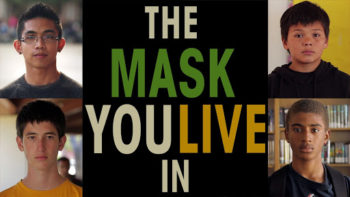Full Transcript:
Happy National Eating Disorders Awareness Week! [Melissa A. Fabello. Philadelphia, PA, USA.] Of course, it isn’t happy that eating disorders exist, but it is happy that we have time to raise awareness and bust myths about them. So today, as both a media literacy educator and an eating disorder survivor, I want to talk about the relationship – or, actually, non-relationship – between eating disorders and the media.
[Everyday Media Literacy. With Melissa A. Fabello. For Miss Representation.]
[How Eating Disorders Work] Eating disorders are a type of mental illness that affects thoughts and behaviors associated with food. The DSM-V, which is scheduled for release in May of this year, recognizes anorexia nervosa, bulimia nervosa, binge eating disorder, and pica as categories, but also includes a catch-all diagnosis for other similar disorders, currently known as EDNOS – Eating Disorder Not Otherwise Specified. [The DSM revision plan includes changing EDNOS to FEDNEC: Feeding or Eating Disorder Not Elsewhere Classified.] The important thing to note about eating disorders is that they are “conditions defined by abnormal eating habits…to the detriment of an individual’s physical and mental health” (cite). That is, THEY’RE NOT DIETS.
[Different from Dieting] While disorders like anorexia and bulimia nervosas can be characterized by an obsession with caloric intake and weight loss, those preoccupations have less to do with wanting to look a certain way and a lot more to do with unfounded fears of fat, weight gain, and food. This isn’t about purposefully acting out a script because of a personal preference, like dieting is. Eating disorders are categorized by a loss of self-control and an inability to think and behave rationally – because it’s a mental illness. So when you compare the symptoms of an eating disorder to the qualities of a diet, it’s similar to conflating depression with sadness, anxiety with stress, or obsession with fixation. The former are all disordered behaviors; the latter are all normal, healthy human emotions. Recognize the difference.
[The Media] The media does not cause eating disorders. Just like it doesn’t cause people to experience any other mental illness. Blaming the media for eating disorders is a dangerous trend because it helps create stigma around eating disorders, making it harder for people to get help: it turns them into conscious choices – an effort made by the individual to obtain an unrealistic beauty standard – rather than an effect of brain chemistry. The media doesn’t cause eating disorders any more than it causes people to commit murder. What it can do is trigger an already predisposed brain, but more often, what media images do is negatively affect body- and self-image, which in turn can lead to extreme dieting.
Consider this: 3 out of 4 girls feel depressed, guilty, and shameful after three minutes leafing through a fashion magazine. 48% of them wish they were as skinny as models, and 31% of them admit to starving themselves to lose weight (cite). And considering that the average American teenager consumes almost eleven hours of media everyday (cite), that is certainly alarming. There is absolutely a connection between media representations of gendered bodies and taking extreme measures to meet those ideals, and there are similarities between extreme dieting and some eating disorders, but connectedness does not always equal correlation.
[The Root Problem] The fact is: the media shows very limited representations of bodies, with the underlying message that some bodies deserve more respect (value, success, appreciation, adoration) than others. (NO!) And some people see that and make the connection that a “perfect” body somehow equals a “perfect” life – and people will test limits to obtain that kind of perfection. There’s a meme floating around Tumblr, for instance, that says, “When I’m Skinny, I’ll Be Happy.” This is NOT AT ALL true! What it IS, is a fucked up way of thinking that can (and does!) lead to body hatred and extreme dieting. What we need to do is use media literacy to stop buying into and perpetuating this lie.
[Five Ways to Be More Body-Positive] So here are some ways to be more body-positive in your everyday life, to foster body-love for yourself and those around you. 1) Throw away magazines. [Or shut off your TV.] I haven’t purchased a “women’s magazine” in almost a decade, and I don’t even own a television. Want to go on an effective diet? Cut down your consumption of media. 2) Read more body-positive blogs. Adios Barbie, Beauty Redefined, and Proud2BMe are good places to start. 3) Stop indulging in thinspiration (and fitspiration)! “Comparison is the thief of joy,” Theodore Roosevelt once said, and it’s true! Check out anti-thinspo Tumblrs like Curve Appeal, Say No to Thinspo, and We Are Anti-Thinspo. Or, if you’re in recovery and want some awesome recovery Tumblrs to follow, Life Without ED and Recovery Is Beautiful are my two favorites. 4) Spend more time naked. Seriously! You can’t learn to love your body if you don’t get to know it first. Shed your clothes when you don’t need ‘em and take time to look at and appreciate your body. And 5) Focus on what your body can do, rather than on how it looks. Because your body is a super awesome gift – and you know what happens when you look a gift horse in the mouth.
So go! Learn more about eating disorders. Understand the things that you do that might perpetuate myth and stigma. Post something to Facebook or Twitter today that educates others about how eating disorders do (and don’t!) work. Talk to someone about ways to be more body-positive. And above all else, love yourself.
Check out Melissa’s website ToughXCookies.com and follow her on Twitter @fyeahmfabello



